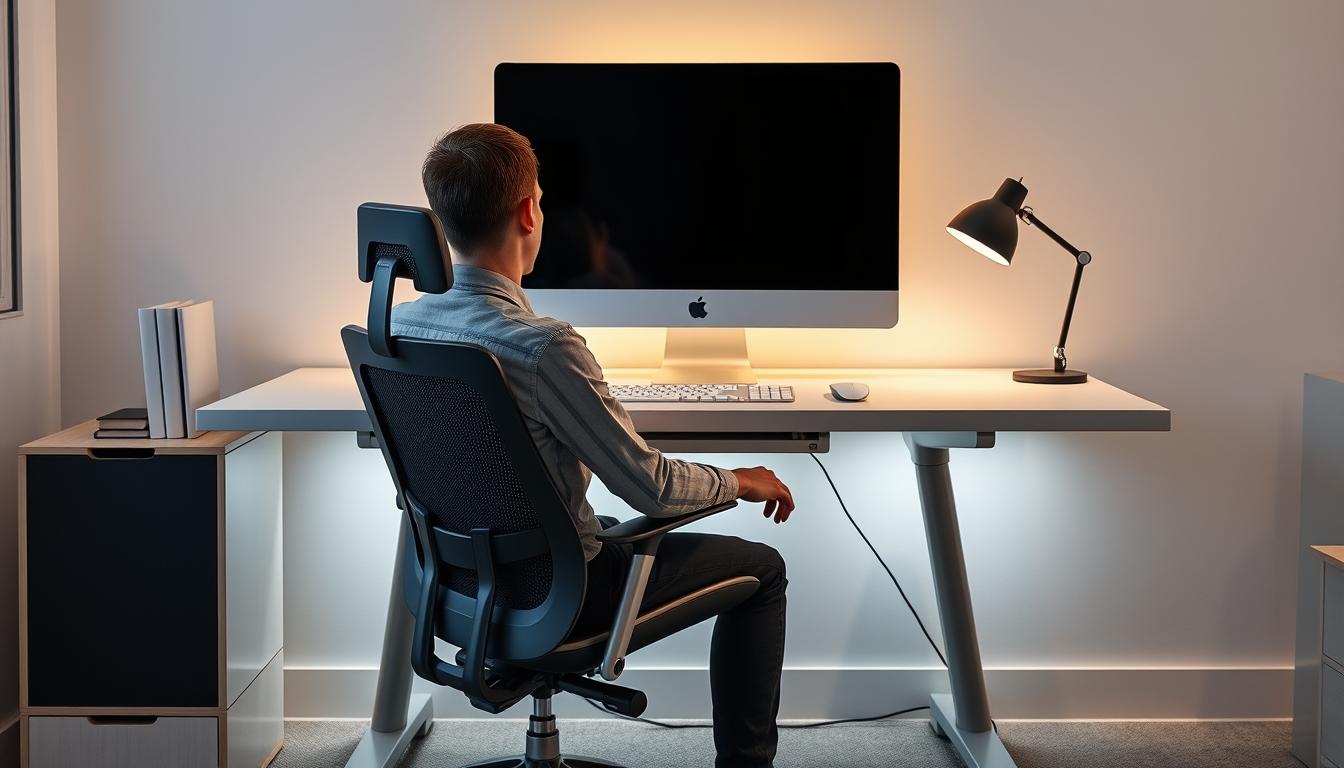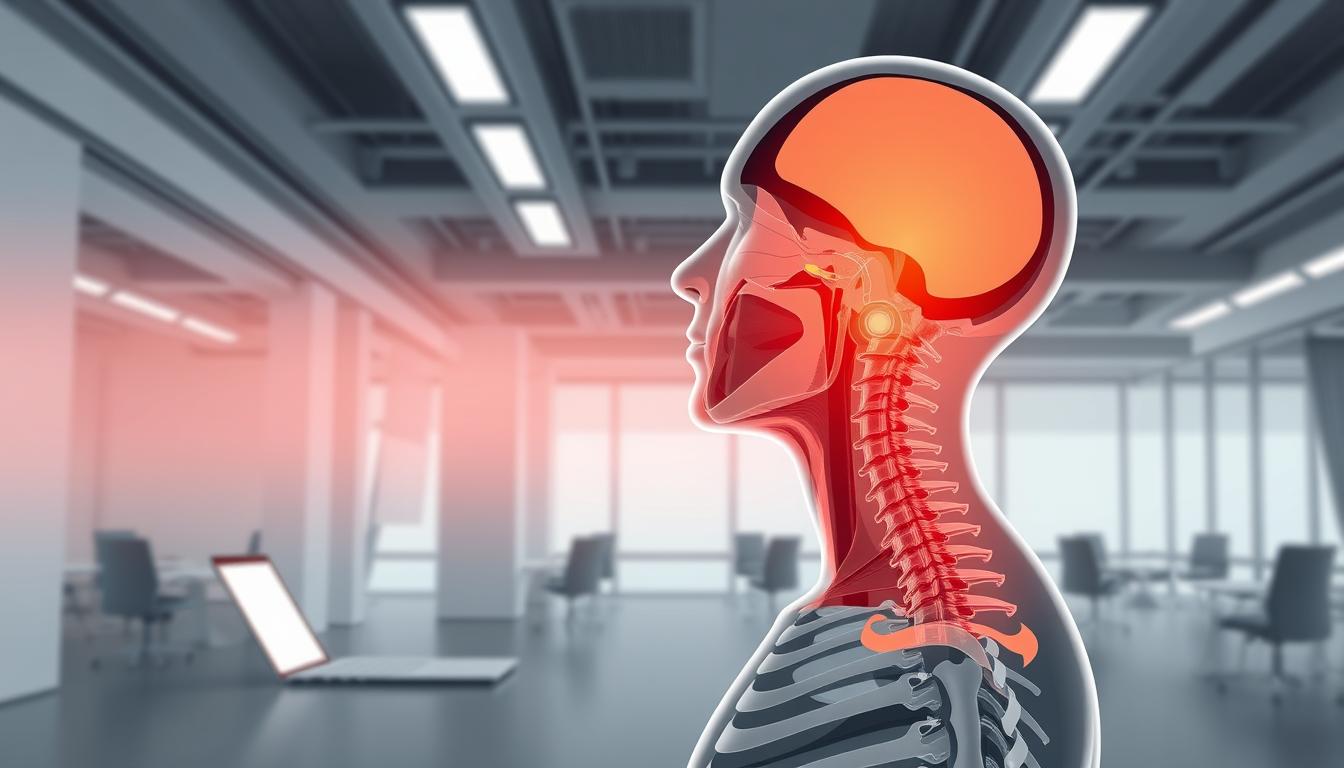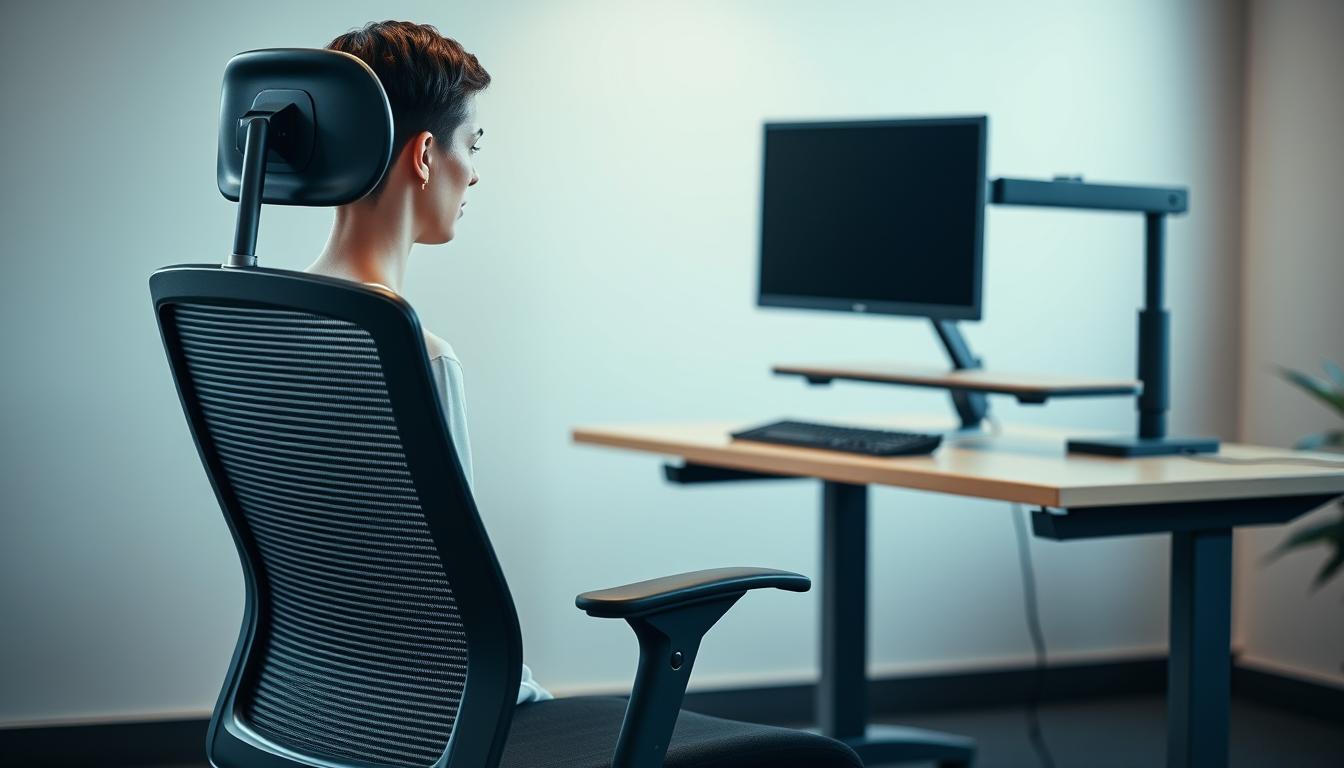Today’s work life moves quickly, making office ergonomics crucial for keeping employees healthy. Poor ergonomics can lead to neck pain, a common issue. Knowing how to set up a workspace right can make work more comfortable and increase effectiveness.
Making small changes and using the right techniques can stop neck pain. This often comes from looking at screens too much or bad sitting positions. Keeping neck pain away is key for staying healthy and productive at work.
Understanding the Importance of Ergonomics in the Office
Ergonomics is key to keeping a healthy workplace. It’s about making workspaces fit what employees need. This helps them be more comfortable and get more done. Proper ergonomics also cuts down on injuries at work. This is really important in offices where people sit a lot and might not have the best setup for their desks.
Using ergonomic practices means less strain on workers’ bodies. This stops problems like neck pain from happening. They come from staying in one place too long without good support. Knowing all about ergonomics helps people start good habits. This makes an office where everyone can do well, feeling good in body and mind.
Common Causes of Neck Pain in Office Settings
Understanding office-related neck pain helps workers take early action. Bad posture is often a main cause of neck discomfort. This, combined with bad work habits, can lead to muscle strain and ongoing issues.
Poor Posture and Its Effects
Poor posture is a key reason office workers suffer from neck pain. Slouching and looking down at screens puts a lot of strain on neck muscles. This results in tension and discomfort. Without changes, this can turn into chronic pain affecting daily life.
Static Positions and Their Impact
Staying still for too long causes neck stiffness and pain. Even with good office chairs, not moving enough can hurt. Our bodies need to move, so breaks are crucial.
Staying in one pose too long stresses neck muscles and ligaments. Moving regularly helps avoid these issues and makes for a healthier workplace.
Office Ergonomics 101: Neck Pain Prevention
To prevent neck pain, it’s key to use good ergonomic setups. Adjusting your work area can boost both comfort and how well you work. Start by making sure your computer screen is right at eye level to lessen strain.
It’s also important to have your chair set right, so your posture is good. This helps keep your spine’s natural shape supported.
Moving around during the day is vital too. Make time for stretching and switching up how you’re sitting. Changing how you sit once in a while helps ease neck muscle tension.
Keep your desk tidy to avoid unnecessary reaching or twisting. Such movements can cause pain.
Using items like keyboard trays and chairs that offer good support can improve your setup. These tools help maintain the right posture while working and encourage healthy work routines. Caring about ergonomics helps protect your neck and makes office life better.
Setting Up an Ergonomic Workspace
Making your workspace ergonomic is key for staying comfy and avoiding neck pain. It’s important to set up your monitor, chair, and desk the right way. This helps you work better and feel good, even after many hours.
Monitor Positioning
Keep your monitor at eye level, about 20-30 inches away. This helps prevent neck strain and keeps your posture straight. Don’t tilt your head, as this can cause discomfort after a while.
Chair Adjustments
A good chair supports your back the right way. Make sure you can sit with your feet on the ground and your knees bent right. A chair with good lower back support stops you from slumping and keeps you comfortable.
Desk Height Considerations
Your desk should let your arms rest easy while typing. If it’s too high or low, think about an adjustable desk. This keeps your posture correct and makes your workspace better for you.
Tips for Maintaining Good Posture
Maintaining good posture is key for overall health, especially to avoid neck pain. It depends on keeping your head straight and your spine natural. Making small changes can boost comfort and productivity a lot.
Alignment of Head, Shoulders, and Spine
Aligning your head, shoulders, and spine properly can cut down on neck strain. Don’t let your head stick out in front. This bad habit can make neck muscles tense up. Keeping your head in line with your shoulders and spine helps. It makes sure you have the right support and less pain through the day.
Frequent Posture Checks Throughout the Day
Checking your posture often is a good way to keep it right and avoid pain. Try to do posture checks at least once every hour. Set reminders to keep a good desk posture, which makes you more aware. These little fixes improve spine health and make working more comfortable.
Incorporating Regular Breaks and Movement
Maintaining focus in an office can be hard when your neck hurts or you feel tired. It’s key to take regular breaks and move around to stay well at work. Quick breaks throughout the day can greatly improve how you feel, especially your neck.
Importance of Micro-Breaks
Taking short breaks every 30-60 minutes fights muscle tiredness and stiffness. Stretching or walking briefly helps blood flow and makes muscles less tight, which can help your posture. By stopping to stretch or walk during the day, you can avoid neck pain and feel more comfortable.
Implementing the 20-20-20 Rule
The 20-20-20 rule suggests looking at something 20 feet away for 20 seconds every 20 minutes. This helps avoid eye strain and lets you reset your posture, easing neck tension. Following this rule is good for your eyes and helps you sit better, making you more focused and engaged at work.

Effective Stretches and Exercises for Neck Pain Relief
Adding a stretching routine to your day can ease neck pain. Simple neck exercises boost flexibility and lessen stiffness. These activities encourage better neck health and reduce tension.
Neck Tilts and Rotations
Neck tilts and rotations are basic but helpful exercises. Tilt your head, bringing your ear close to your shoulder, and hold. This movement feels good. Then, for rotations, turn your head to look over your shoulder, switching sides. Do these during short breaks for fast relief.
Shoulder Rolls and Seated Twists
Shoulder rolls and seated twists help relax the upper body. Roll your shoulders in circles to loosen up. Sit and twist gently for spinal health with little effort. Adding these to your daily habits improves posture and eases pain.
Supportive Tools for Your Workspace
Making your workspace comfy is key to staying on task and avoiding neck pain. By adding ergonomic tools, your work area gets more cozy. These items help right away and also keep you healthier in the future.
Ergonomic Chairs and Accessories
Ergonomic chairs help support your back and neck the best way. They let you change their height, have back support, and padding to lessen strain. Adding things like support for your lower back, rests for your wrists, and something to prop your feet on makes sitting even better. They help you sit correctly, making it less likely you’ll feel bad later.
Standing Desk Options
Standing desks are now a favorite because they let you move more during the day. They make it easy to switch between sitting and standing, fighting the downsides of sitting too much. This kind of desk setup is great for your overall muscle and joint health, helping you feel better and avoid neck strain over time.
When to Seek Professional Help for Neck Pain
If your neck pain won’t go away with simple fixes, it’s time to see a pro. Lingering neck pain might mean you have a bigger issue that needs a doctor’s care. Problems like pulled muscles, slipped discs, or pinched nerves often need expert help.
Don’t wait too long to get checked out. Physiotherapists or chiropractors can make a plan just for you. They’ll give you special exercises. These will help you move better, hurt less, and make your neck stronger.
Overlooking neck pain can cause bigger troubles later. Making health a priority by reaching out to experts can improve your life. It can help you feel and function better.
Conclusion
Fixing neck pain with good workspace setup is needed and good for a healthy workplace. Making small changes and moving often can make you feel better and work better. By improving your desk setup, you help yourself and everyone at work.
People who pay attention to how they sit and where things are on their desk will hurt less. Ergonomics is super important for feeling good now and staying healthy later on. By using ergonomic tips, work becomes more fun and you can do your best.
Creating a better work area takes effort and ongoing changes. Using the right tools, making changes, and listening to what your body says can improve your health and work happiness.



